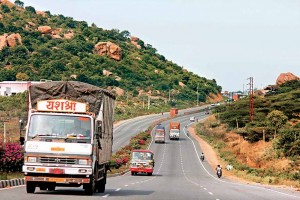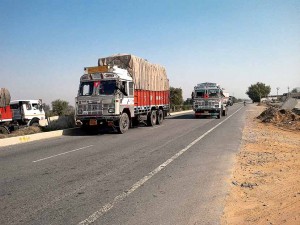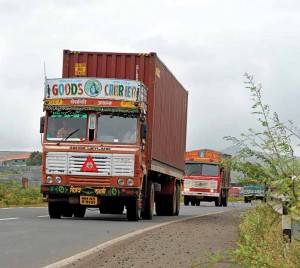Demonetisation affected numerous truck and bus operations in India.
Story by:
Bhushan Mhapralkar
While many may hail prime minister Narendra Modi’s decision to strike out Rs.500 and Rs.1000 notes, and introduce new Rs.2000 notes in an effort to curb black money, and the menace of fake currency, the effect of what is being termed as demonetisation is affecting every Indian, or it seems. Since November 8, 2016, after the prime minister announced the demonetisation measure, the transport sector is looking bruised. Accounting for roughly 4.5 per cent of India’s GDP, the transportation sector, which includes numerous truck and bus operators, is having to deal with the prospect of over 80 per cent of the currency taken out of circulation overnight. The economy of India, Asia’s third-largest, is said to be heading towards a liquidity crisis. Truck and bus operators (transporters) are finding it challenging. Especially with the flow of new notes controlled by the government. Supply chains at small, medium and even large companies are claimed to be breaking down. With corporate operating profits feared to fall by as much as 40 per cent in the current quarter, it is not just the taxi drivers, street hawkers and big consumer goods firms that are seeing their earnings plummet, truck and bus operators are seeing their flow charts being curtailed.
Transporter hardships
Transporter hardships are best described by the fall in fleet utilisation levels. According to Hemant Laddha, Director, Shivani Carriers Pvt. Ltd., fleet utilisation has fallen by 25 per cent. Mukund Desai, Managing Director, Mukund Roadlines Pvt. Ltd., is of the opinion that his fleet utilisation is down by 40 per cent. Avers Sanjay Sharma of Assam Transport Service, that fleet utilisation is down by 40 per cent. “Because of cash crunch, our trucks are stranded at various places,” he states. Sharma explains that they cater to corporate clients who pay them through bank transfer. For return transportation, Sharma’s company relies on food grain traders. It is here that the issue is more acute; food grain commerce is cash intensive, and the sector, according to Sharma, is down by 50 to 60 per cent.
Catering to the FMCG sector, Laddha operates a fleet of 110 trucks. The issue, he feels, is towards the remittance of Rs.30,000 to Rs.40,000 towards operating a truck. The sum, he explains, involves cash expenses towards loading and unloading of goods, driver allowance and toll. “We have RFID tags for tolls, but not all tolls are RFID ‘ready’, adds Laddha. Sharma states, that even if he were to pay the driver by making a NEFT transfer as every driver today has a debit card, the difficulty lies in him withdrawing the money. “With most ATMs out of order, and withdrawals restricted to Rs.2000, it is simply impossible to operate a truck.” he adds. Claims Laddha that he is managing to keep the business going by paying the driver a mix of old and new currency notes. “For example, out of an allowance of Rs.5000, we are giving the driver Rs.2000 old notes and Rs.3000 new notes,” he says. With buyers beginning to postpone their purchases, Laddha feels that the FMCG business has began to pause. This, he states, is a sign of the economy slowing down. “More time is spent in a queue, and adjustments have become a primary activity over all other activities,” mentions Laddha.
Echoing the sentiments of Laddha and Sharma, Desai, who operates a fleet of 50 trucks, opines that they are facing hardships when it comes to driver allowance. “An expense of between Rs.50,000 and Rs.100,000 is incurred,” he adds. In what could well define the extent of difficulties faced by the transporters, Manjinder Singh Dhaliwal, Secretary, Maharashtra Tanker and Lorry Owner’s Association, says that they are the worst affected due to demonetisation of Rs.500 and Rs.1,000 currency notes. As one of the largest unorganised and cash-based sectors of the country we are facing immense problems, he adds. Informs Sharma, “At various border passings, there are these fine slips which the RTO is demanding, and have to be paid in new currency notes. Even the government offices are refusing to accept old currency notes.” Claims an industry source on the condition of anonymity, that even those who are seeking bribes are insisting on new currency notes.
Bus operator woes
Buses in India touch the lives of every citizen. They come in various sizes, forms and are used for the most diverse functions ever imagined. The industry is made up of private and public bus operators. Public bus operators are termed as semi-government bodies and run a business model that is subsidised through government funding. This underlines the socialist agenda that concerns buses in India as they move people within cities, and between cities as well as villages. Competing with, and yet carving out a business model of their own are the private bus operators. They could be an owner of a single bus, or of a fleet that is no less than a whopping 8000-10000 buses. Demonetisation is claimed to have affected the business of both, public and private bus operators. There are less people moving around as businesses begin to slow down. Says K T Rajashekhara, CEO, S.R.S. Travels, “Our flow chart is getting curtailed as people are curtailing travel due to the money crunch.” Of the opinion that road connectivity is lacking in India, and the law is against road transporters, Rajashekhara avers that bus travellers have shrunk by 50 per cent since the demonetisation measure came into force. Stressing upon the need to customise the laws framed for road transporters as they are restricting the sector growth, and thus the overall economy, Rajashekhara sounds concerned about the factors that have played out over the last few months. He says, “Now it is the issue of demonetisation; yesterday it was the issue of Cauvery. The day before, there was something else. For us, transporters, there are too many hurdles to be tackled. And, they have been affecting our flow chart. Business has gone down, but taxes remain as they are. This means, our fixed costs continue to be high – towards the payment of insurance, various government taxes, and salaries. Operations are being hampered as staff punctuality has gone down. Our employees stand in long queues to withdraw small sums of money to run their household.” Of the firm opinion that laws for transporters have to be customised, and take a long time to change, Rajashekhara explains, “Toll closure does not affect us as much as the fixed costs do. Taxes especially. While business for the last one month was affected, there was no concession in taxes, offered. Compared to a truck, which accounts for Rs. 35000 in taxes for one year, taxes for a bus amounts to Rs. 800,000 per year.” Operating a 8000 bus fleet, including long distance luxury coaches like the Bangalore-Jodhpur (2000 km) service, S.R.S. Travels is one of the leading private bus operators in the country.
Shedding the baggage
Under the condition of anonymity, quips a transporter that many customers, in a bid to let go off their old currency, have paid them in old higher denomination notes. If a transporter refuses to accept old notes, he is threatened that no revenue will come his way, he adds. SP Singh, Convenor, IFTRT, is of the opinion that cash flow in the transport industry is not an issue. The issue, he adds, is the steep fall in cargo despatch post demonetisation, as businesses and traders do not procure goods due to unsold inventories.” The drop in fleet utilisation has been sharp,” he adds. Claims Singh that businesses and traders are used to having almost 50 per cent of the transactions out of the books, and common carriers and transport agents have been facilitating this to escape excise duty, VAT, Service Tax, etc. He adds that an estimated Rs.45,000 crore worth of unaccounted money has been pumped into the transport industry since November 9, 2016. This is being done by making payment in old notes towards the purchase of diesel, and by paying the employees. Pressure, says Singh, is being put on the government to extend the toll exemption deadline. While utilisation of country’s nearly 85 lakh trucks is said to be down by almost 40 per cent since demonetisation was announced, and is attributed to the fall in cargo movement, the fact is, opines Singh, that the common carriers and transport intermediaries are busy seeking an extension for cash acceptance of Rs.1,000 and Rs.500 old notes, toll exemption, and higher cash withdrawal limit on exaggerated claims. Many other difficulties are being cited too. “Many transporters and businesses are busy neutralising their books of accounts by exchanging transaction with 20-30 per cent cut offered to people needing to dispose off real unaccounted currency at mass levels so that unethical and under-reporting of transactions could resume after 50 days with business being as usual,” adds Singh.
Optimism prevails
Despite the hurdles, transporters are optimistic. Much like the Indian population, they are of the impression that this is a passing phase. Some are of the opinion that a long-term framework towards improving the business environment may be necessary, Others think that things will soon limp back to normalcy. Says Laddha, that he hopes normalcy to return soon. It is this optimisim that is keeping the truck and bus operators going.
Taxi woes
Taxi operators have seen their business mellow down in the wake of the currency crisis since November 09, 2016. The worst hit are the conventional taxis as against the likes of Meru, Ola and Uber. The Ola money digital purse has proved to be useful to both, the taxi operators and the travellers since it does not entail any cash transaction. With conventional taxis, the situation is not as good. The pre-paid taxi counters at Mumbai’s Sahar International airport are said to have shut down for a few days since the taxis could not be paid due to the shortage of new curency. Though the conventional, black and yellow cabs, that run as pre-paid taxis make the most cost effective way to travel among other taxi means, the shortage of currency is ensuring that such operators are asking for random sums, which may be on par with what a traveller would have paid at the pre-paid counter. A sense of mistrust is however taking hold of the situation. In an instance of travel within the city, cab drivers are in no mood to turn down a ride, but do not have change to offer at the end of it. Business, opined a Mumbai cab driver, is down 50 per cent, since November 09, 2016.




























